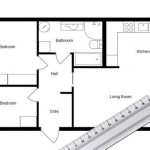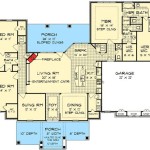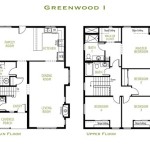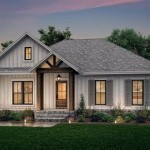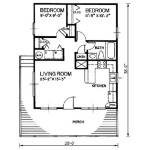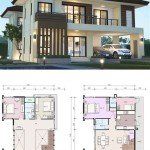Two-Bedroom House Floor Plans: A Comprehensive Guide
Two-bedroom house floor plans are a popular choice for a variety of homeowners, from young professionals and small families to retirees and individuals seeking a manageable living space. Their versatility stems from their ability to provide a comfortable and functional environment without the extensive square footage and associated costs of larger homes. Understanding the nuances of two-bedroom floor plans is crucial for making informed decisions about designing, building, or purchasing a home that effectively meets specific needs and lifestyle preferences. This article provides a comprehensive overview of the key considerations, design variations, and practical benefits associated with two-bedroom house floor plans.
The fundamental appeal of a two-bedroom house lies in its balance between space efficiency and livability. It offers distinct advantages over one-bedroom options by providing an extra room that can serve multiple purposes, such as a guest room, home office, hobby space, or children's bedroom. This flexibility makes two-bedroom homes a practical choice for individuals anticipating future needs or those who simply desire more space for personal pursuits. Furthermore, compared to larger homes with three or more bedrooms, two-bedroom houses typically require less maintenance, consume less energy, and are more affordable to purchase or rent.
The design and layout of a two-bedroom house significantly impact its overall functionality and perceived spaciousness. Careful consideration must be given to factors such as room sizes, spatial relationships, natural light, and storage solutions. A well-designed floor plan will maximize the use of available space, create a comfortable living environment, and enhance the overall value of the property. The following sections will delve into key aspects of two-bedroom house floor plans, providing insights into optimizing space, considering different design styles, and adapting plans to individual needs.
Optimizing Space and Layout in Two-Bedroom Homes
Efficient space utilization is paramount in two-bedroom house floor plans. Every square foot should be carefully considered to ensure that the living spaces are both functional and comfortable. The layout should prioritize natural flow and minimize wasted space, creating a sense of openness and ease of movement throughout the home.
One of the primary considerations is the arrangement of the living areas. An open-concept design, which integrates the living room, dining area, and kitchen, is a common approach for maximizing space and promoting social interaction. This layout eliminates walls and partitions, creating a larger, more unified living area. The strategic placement of furniture and the use of visual cues, such as rugs and lighting, can help to define distinct zones within the open space.
The bedrooms should be designed to provide privacy and tranquility. They should be located away from the main living areas to minimize noise and disruption. The size of the bedrooms should be proportionate to the overall size of the house, with sufficient space for a bed, nightstands, and a dresser or wardrobe. Adequate closet space is essential for storage and organization. In master bedrooms, consider adding an en-suite bathroom for added convenience and privacy.
The bathroom(s) should be functionally designed to accommodate daily routines. A well-designed bathroom will include essential fixtures such as a toilet, sink, and shower or bathtub. Storage solutions, such as cabinets and shelves, are crucial for keeping toiletries and personal items organized. Consider incorporating natural light through windows or skylights to create a brighter and more inviting space.
The kitchen should be designed with efficiency and functionality in mind. A well-organized kitchen will include ample counter space, storage cabinets, and essential appliances such as a refrigerator, oven, and dishwasher. The layout of the kitchen should facilitate efficient workflow, minimizing the distance between the sink, stove, and refrigerator. Consider incorporating a kitchen island or breakfast bar to provide additional counter space and seating.
Hallways and corridors should be minimized to avoid wasting valuable square footage. When hallways are necessary, they should be designed to be as narrow as possible while still allowing for comfortable passage. Consider incorporating storage solutions, such as built-in shelves or cabinets, into hallways to maximize their functionality.
Exploring Different Two-Bedroom House Plan Styles
Two-bedroom house floor plans are available in a wide range of architectural styles, each with its unique features and aesthetic appeal. The choice of style should be based on individual preferences, the surrounding environment, and budgetary considerations. Understanding the characteristics of different styles can help homeowners make informed decisions about the design of their two-bedroom home.
Ranch-style homes
are characterized by their single-story layout, low-pitched roofs, and horizontal orientation. They are often designed with an open floor plan and large windows that allow for ample natural light. Ranch-style homes are well-suited for individuals seeking single-level living and are often popular among retirees and those with mobility issues.Craftsman-style homes
are known for their attention to detail, handcrafted features, and natural materials. They typically feature low-pitched roofs, wide eaves, exposed rafters, and a prominent front porch. Craftsman-style homes often incorporate wood trim, built-in cabinets, and other artisanal details that add to their charm and character.Modern-style homes
are characterized by their clean lines, minimalist design, and emphasis on functionality. They often feature flat roofs, large windows, and open floor plans. Modern-style homes prioritize natural light and ventilation and often incorporate sustainable materials and energy-efficient technologies.Traditional-style homes
encompass a wide range of historical architectural styles, including Colonial, Victorian, and Georgian. These homes are often characterized by their formal layouts, symmetrical facades, and decorative details. Traditional-style homes typically feature separate living and dining rooms, as well as a grand entryway and staircase.Contemporary-style homes
are a blend of modern and traditional design elements. They often feature open floor plans, large windows, and clean lines, but they also incorporate elements of warmth and character, such as natural materials, textured finishes, and comfortable furnishings. Contemporary-style homes are designed to be both functional and aesthetically pleasing.Adapting Two-Bedroom Plans to Individual Needs
While there are many pre-designed two-bedroom house floor plans available, it's often necessary to adapt these plans to meet the specific needs and preferences of the homeowner. Customization can involve modifying the layout, adding or removing features, or adjusting the overall size of the house. The goal is to create a home that is perfectly tailored to the individual's lifestyle and requirements.
One common adaptation is to convert one of the bedrooms into a home office. With the increasing prevalence of remote work, having a dedicated workspace is essential for many individuals. The bedroom can be transformed into a functional office by adding a desk, shelving, and appropriate lighting. Consider soundproofing the walls to minimize distractions and create a more productive work environment.
Another common adaptation is to add an extra bathroom. This can be particularly beneficial for families or individuals who frequently have guests. Adding a second bathroom can improve convenience and reduce conflicts over bathroom usage. The additional bathroom can be a full bathroom with a shower or bathtub, or it can be a half bathroom with just a toilet and sink.
Some homeowners may choose to expand the kitchen or living area to create more space for entertaining or cooking. This can involve removing walls, adding an extension, or reconfiguring the existing layout. Consider the flow of traffic and the placement of furniture when making these changes to ensure that the space remains functional and comfortable.
Storage solutions are often a critical consideration when adapting two-bedroom house floor plans. Many pre-designed plans lack sufficient storage space, particularly in smaller homes. Adding built-in shelves, cabinets, or closets can significantly improve the organization and functionality of the home. Consider utilizing vertical space by installing shelving systems that reach the ceiling. Under-bed storage and concealed storage compartments can also be effective ways to maximize space.
Finally, consider the accessibility of the home. If you or a family member has mobility issues, it may be necessary to adapt the floor plan to make it more accessible. This can involve widening doorways, installing ramps, and modifying bathrooms to accommodate wheelchairs or walkers. Consider the placement of light switches, outlets, and other fixtures to ensure that they are easily accessible.
By carefully considering these key points, individuals can effectively navigate the selection, design, and adaptation of two-bedroom house floor plans to create a comfortable, functional, and personalized living space that meets their specific needs and lifestyle.

12 Simple 2 Bedroom House Plans With Garages Houseplans Blog Com

Simple 2 Bedroom House Plan 21271dr Architectural Designs Plans

Practical 2 Bedroom House Plan With L Shaped Kitchen

Two Bedroom Small House Plan Cool Concepts Design Plans

Two Bedroom Small House Design Shd 2024030 Pinoy Eplans

2 Bedroom House Plans Open Floor Plan Bungalow Modular Home Condo

2 Bedroom House Plans For Stylish Homes Ck

Country Porches 2 Bedroom Cottage Style House Plan 5712

12 Simple 2 Bedroom House Plans With Garages Houseplans Blog Com

2 Bedroom House Plan Examples


